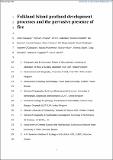Falkland Island peatland development processes and the pervasive presence of fire
Abstract
Palaeoecological analyses of Falkland Island peat profiles have largely been confined to pollen analyses. In order to improve understanding of long-term Falkland Island peat development processes, the plant macrofossil and stable isotope stratigraphy of an 11,550 year Falkland Island Cortaderia pilosa (‘whitegrass’) peat profile was investigated. The peatland developed into an acid, whitegrass peatland via a poor fen stage. Macrofossil charcoal indicate that local fires have frequently occurred throughout the development of the peatland. Raman spectroscopy analyses indicate changes in the intensity of burning which are likely to be related to changes in fuel types, abundance of fine fuels due to reduced evapotranspiration/higher rainfall (under weaker Southern Westerly Winds), peat moisture and human disturbance. Stable isotope and thermogravimetric analyses were used to identify a period of enhanced decomposition of the peat matrices dating from ∼7020 cal yr BP, which possibly reflects increasing strength of the Southern Westerly winds. The application of Raman spectroscopy and thermogravimetric analyses to the Falkland Island peat profile identified changes in fire intensity and decomposition which were not detectable using the techniques of macrofossil charcoal and plant macrofossil analyses.
Citation
Mauquoy , D , Payne , R , Babeshko , K , Bartlett , R , Boomer , I , Bowey , H , Evans , C , Ring-Hrubesh , F , Muirhead , D , O'Callaghan , M , Piotrowska , N , Rush , G , Sloan , T , Smeaton , C , Tsyganov , A & Mazei , Y 2020 , ' Falkland Island peatland development processes and the pervasive presence of fire ' , Quaternary Science Reviews , vol. 240 , 106391 . https://doi.org/10.1016/j.quascirev.2020.106391
Publication
Quaternary Science Reviews
Status
Peer reviewed
ISSN
0277-3791Type
Journal article
Description
RJP secured funding for this research from the Quaternary Research Association, University of York and the Russian Science Foundation (19-14-00102).Collections
Items in the St Andrews Research Repository are protected by copyright, with all rights reserved, unless otherwise indicated.

